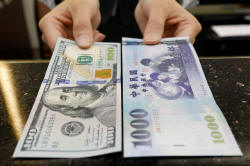|
On a mission: Taiwan
central bank chief's bid to escape U.S. currency glare
 Send a link to a friend
Send a link to a friend
 [May 16, 2017]
By Liang-Sa Loh and J.R. Wu [May 16, 2017]
By Liang-Sa Loh and J.R. Wu
TAIPEI
(Reuters) - As he counts down his final months at the helm of Taiwan's
central bank, Governor Perng Fai-nan has made it his mission to get
Taiwan off the U.S. government's list of possible currency manipulators
by turning on its head a decades-old policy of keeping the currency
weak.
The change is bearing some fruit, but Perng is in a race against time to
completely remove Taiwan from the U.S. government's list of countries
being monitored for currency manipulation before he leaves office early
next year.
While the U.S. Treasury has recognized Taiwan's efforts to reduce
currency intervention to suppress the strength of the Taiwan dollar <TWD=>,
it wants to make sure the change is longer lasting before taking the
island off of its watchlist. Others on the U.S. watchlist include China
and Germany.
Under U.S. rules, economies with a hefty trade surplus with the United
States, a current account surplus exceeding 3 percent of their GDP and
which use heavy intervention would be labeled currency manipulators and
could be subject to punitive measures.

The criteria, introduced in 2016, gave Taiwan's central bank a roadmap
to follow. Its trade surplus with the United States was below the U.S.'
threshold, while its current account surplus as a small, trade-reliant
economy, was well above the threshold at 13 percent of GDP.
So the central bank's best hope to get off the watchlist was to ease up
on intervention, central bank officials said.
Now, the United States sees Taiwan heading in the right direction, the
head of the central bank's foreign exchange department suggested.
"This time Taiwan only fulfilled one criteria," said Harry Yen,
referring to the U.S. Treasury's latest twice-yearly currency
manipulator report in April.
DRAMATIC TURN
The change in currency policy marked a dramatic turn for a trading
island that punches way above its economic weight.
For nearly two decades, Perng's management of the exchange rate had been
seen at home as a pillar of support for exporters, which fuel more than
half the economy and are vital to many global technology supply chains.
Over the years, Perng was a regular in the central bank's trading room,
barking orders to directly manage the currency, central bank officials
said. A fish tank was installed in the trading room, filled with
cichlids that are known for being nimble and fast – something the
central bank dealers wanted to emulate in currency markets.
"If changes in the market are very big, Perng will take command when he
is in the trading room," said a central bank official, who declined to
be identified because of the sensitivity of the issue.
Neither Perng nor his office wanted to comment for this story.
Under the central bank's tight management, the Taiwan dollar fell 14
percent against the U.S. dollar between early 2011 and 2016.
But since Perng changed policy, the Taiwan dollar has risen sharply. It
is up 7 percent against the dollar this year alone, sitting alongside
the Korean won as Asia's strongest major currency.
[to top of second column] |

A teller poses with U.S. $100 and New Taiwan dollar (TWD) $1000
banknotes at a bank in Taipei, Taiwan February 23, 2017.
REUTERS/Tyrone Siu/File Photo

The
shift was rewarded by the U.S. Treasury, which said in its October 2016 report
that the Taiwan central bank had cut back on its "intervention at the end of the
trading day, which many market participants had viewed as a preference for
currency depreciation."
By April 2017, Treasury officials said Taiwan's intervention had fallen below
red-line levels, so it no longer met the intervention criterion, but they kept
it on their watchlist because they were not convinced the change was long
lasting.
Taiwan can only be removed from the watchlist when it meets only one criterion
for two consecutive Treasury reports.
The U.S. Treasury said Taiwan needs a "durable, not one-off" improvement to get
off the watch list. Another potential delay could be a disagreement over how
income on the island's $438 billion in currency reserves is calculated, Taiwan
sources said. The Treasury sees the income as evidence of intervention.
UNKNOWN FACTOR
The change in currency policy has not come without its downside.
The
world's largest contract chipmaker Taiwan Semiconductor Manufacturing Co said
last month that its first-quarter revenue fell short by T$6 billion ($200
million) due to the local dollar's strength.
It said it expected the Taiwan dollar to keep rising, which in turn could hit
its revenue because most of it is denominated in U.S. dollars.
There is also an unknown factor Taiwan may have to contend with in trying to
avoid the currency manipulator label – an unpredictable U.S. president.

Although Donald Trump has toned down his rhetoric since entering office in
January, central bank officials fear Trump might push for a different way to
declare big exporters a currency manipulator.
"For example, if the U.S. economy doesn't do well and America's trade deficit
doesn't improve, the rumblings will get louder and to resolve domestic issues
Trump could 'change the status quo' and Taiwan could stay on the monitoring
list," another central bank official said.
"This report is written by the United States, so it is not something Perng
Fai-nan can control."
(Reporting by Liang-sa Loh and J.R. Wu: Editing by Vidya Ranganathan and Neil
Fullick)
[© 2017 Thomson Reuters. All rights
reserved.] Copyright 2017 Reuters. All rights reserved. This material may not be published,
broadcast, rewritten or redistributed. |